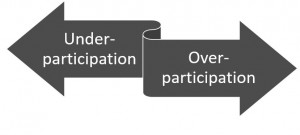Experiences teaching over Zoom, increased student participation, and a new appreciation for synchronous learning
Last Week’s Teaching in 2020 – Episode 3


Experiences teaching over Zoom, increased student participation, and a new appreciation for synchronous learning
Teach students to collaborate before expecting success. Doing group work, peer review, and other collaborative activities without prior training can lead to confusion and dead time in class. For maximum success, teach collaboration skills before starting group projects. ONE IDEA: Introduce peer review workshops at the beginning of the semester using a Fish Bowl approach. Then ask students to critique the modeled peer review session and create a set of class rules for peer review. Use Quick Writes to fill […]
by Jessica Porter, Office of Educational Technology (eTech) Active learning requires students to participate in class rather than sitting and listening to lectures. Techniques include, but are not limited to, discussions, brief question-and-answer sessions, writing and reading assignments, hands-on activities, and peer instruction. In other words, active learning promotes a deeper, more engaging learning experience, and it establishes a much-needed feedback loop for students. Rationale According to recent studies, the average attention span of a typical student is between 10 […]
In this interview with Nathan Loewen, Margaret Peacock talks about her favorite active learning strategies, including a creative project and a collaborative reading exercise. A few of the questions asked: What are your favorite teaching strategies? How do you make the learning stick? About the Speaker Margaret Peacock is an associate professor of history, Leadership Board Faculty Fellow, and the Tuscaloosa-area coordinator the the organization College Admissions Made Possible (CAMP). She teaches undergraduate and graduate courses on the Cold War and Russian and Soviet […]

by Nathan Loewen, Department of Religious Studies Sometimes there is a considerable difference between a professor’s evaluation of a course and those of the students. The divergence can work in either direction. Perhaps a “terrible” experience for the professor was “absolutely brilliant” for the students. Let’s be honest, however: the opposite situation is difficult news. What are the next steps when a professor thinks a course went “just fine” and the students clearly did not? The situation is not rare, based on […]
Read More from Students’ Opinions Instruction are In! Now What?

by Nathan Loewen, Department of Religious Studies The group project regularly begets under-participation. No student situation in college teaching better illustrates the free-rider phenomenon. Perhaps Homer Simpson demonstrates the free-rider phenomenon best. Individuals who receive collective benefits without contributing are common in group work. One or more students in a group project can easily slack off while only one student fulfills the assignment requirements. The online discussion forum, like the group assignment, begets under-participation, too. In most cases, it takes the form of lurking, where students observe […]
Read More from Lurkers, Surfers, and Free-riders: Is Under-Participation a Problem?
by Nathan Loewen, Department of Religious Studies There is a television show on ABC where a professor takes five students under the wing. The teacher is charismatic, unconventional and named Professor Keating. The plot quickly differs from that of the earlier Professor John Keating in Dead Poets Society, except for one thing: both of them get away with murder. Their command of the classroom kills student participation. The show portrays Professor Annalise Keating teaching in a large-enrollment classroom, where she typically strides into the room exactly […]
Read More from How to Get Away with Murder, or How to Kill Student Participation